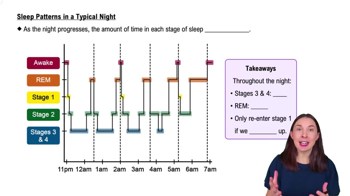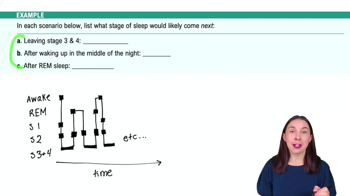Table of contents
- 1. Introduction to Psychology1h 43m
- 2. Psychology Research2h 20m
- 3. Biological Psychology2h 41m
- 4. Sensation and Perception28m
- 5. Consciousness and Sleep32m
- 6. Learning41m
- 7. Memory34m
- 8. Cognition37m
- 9. Emotion and Motivation35m
- 10. Developmental Psychology33m
- 11. Personality48m
- 12. Social Psychology41m
- 13. Stress and Health41m
- 14. Psychological Disorders44m
- 15. Treatment47m
5. Consciousness and Sleep
Sleep
Struggling with Psychology?
Join thousands of students who trust us to help them ace their exams!Watch the first videoMultiple Choice
When under the influence of a stimulant, you are likely to be in a state of
A
waking consciousness.
B
increased alertness.
C
divided consciousness.
D
hypnosis.
 Verified step by step guidance
Verified step by step guidance1
Understand the concept of 'stimulant': A stimulant is a type of psychoactive drug that increases activity in the brain, resulting in increased alertness, attention, and energy.
Identify the effects of stimulants: Stimulants typically lead to heightened alertness and wakefulness, which are characteristics of waking consciousness.
Consider the options provided: increased alertness, divided consciousness, and hypnosis.
Analyze each option: 'Increased alertness' aligns with the effects of stimulants, while 'divided consciousness' and 'hypnosis' do not typically result from stimulant use.
Conclude that the most likely state when under the influence of a stimulant is 'increased alertness', as it directly corresponds to the known effects of stimulants on consciousness.

 3:25m
3:25mWatch next
Master Circadian Rhythms with a bite sized video explanation from Hannah Gordils
Start learningRelated Videos
Related Practice


































































































![Race, Genes and IQ Differences | Bret Weinstein [Mini Clip]](https://img.youtube.com/vi/IztL_m3pd70/mqdefault.jpg)



































































































